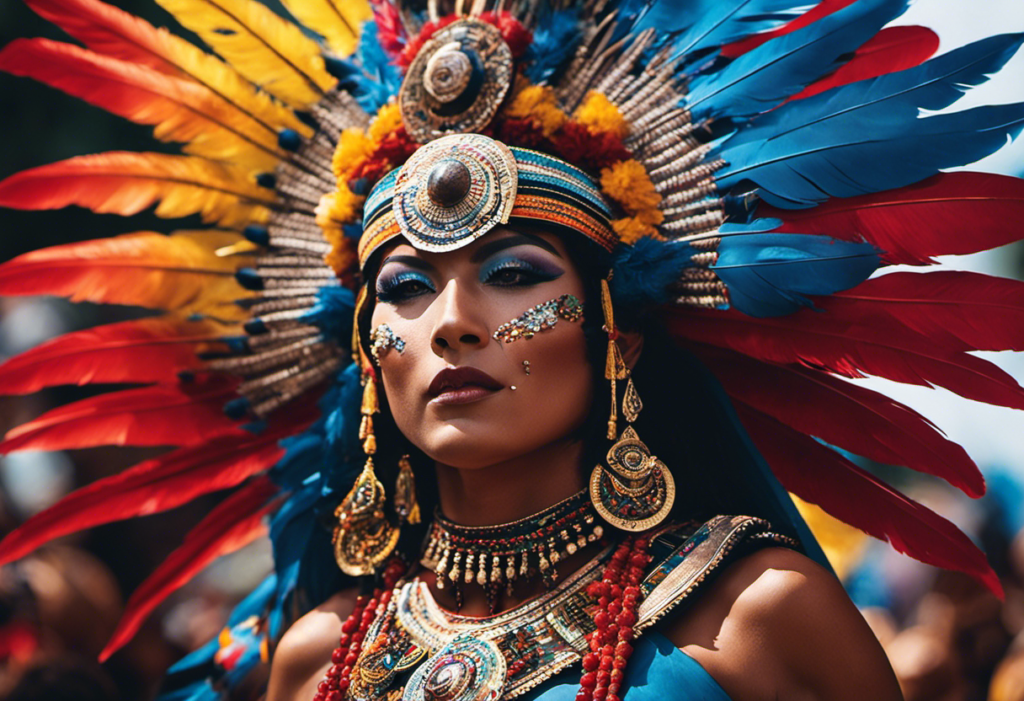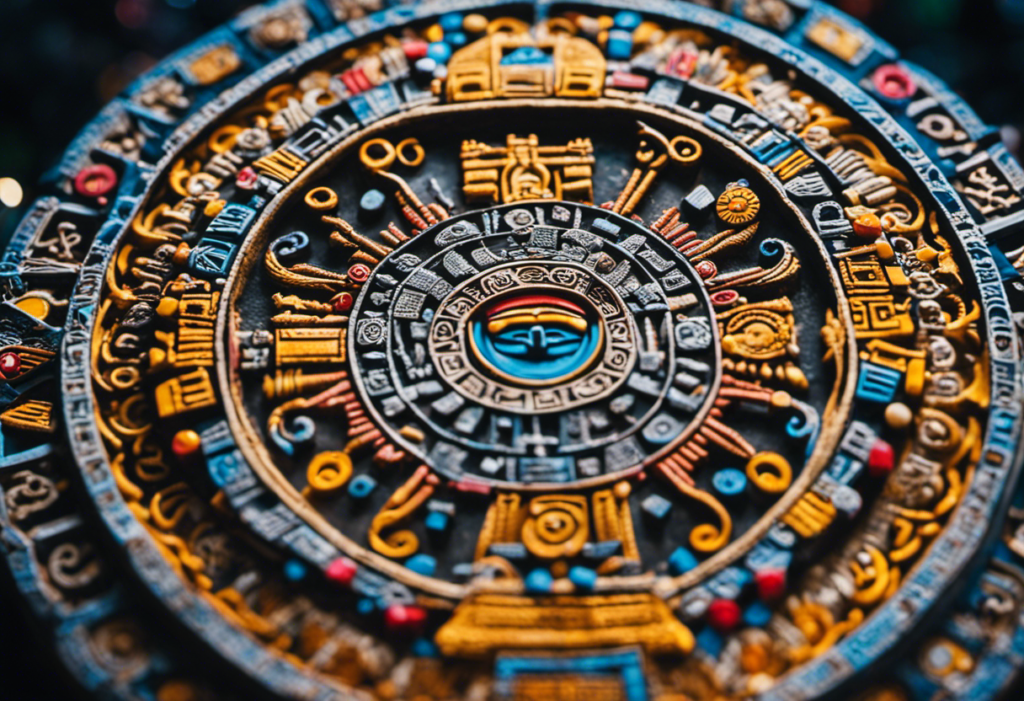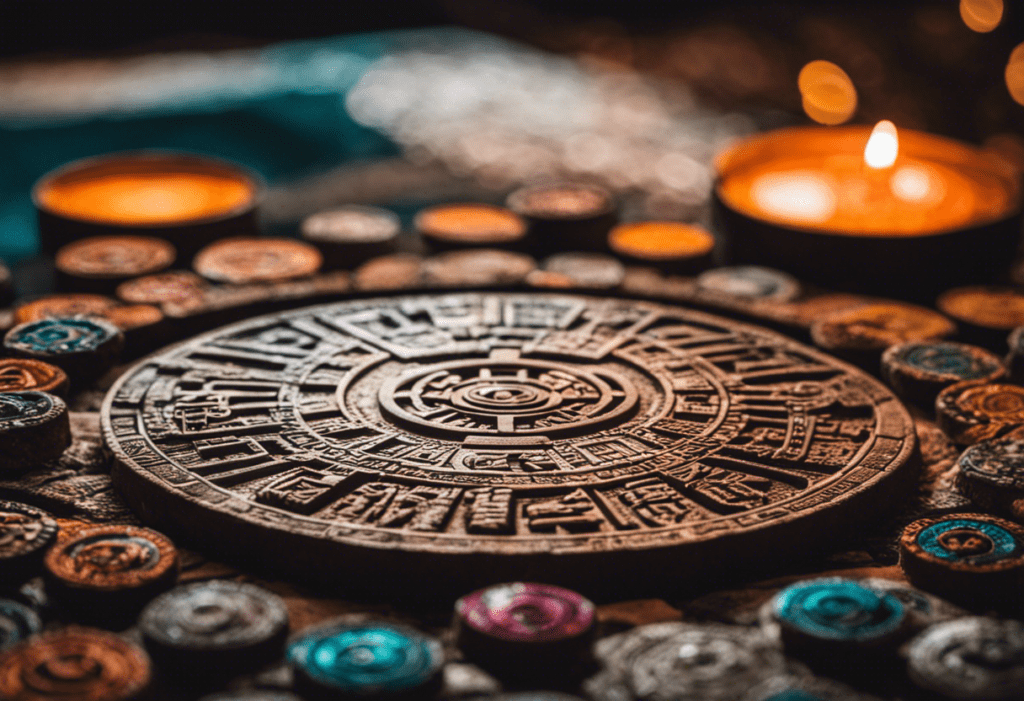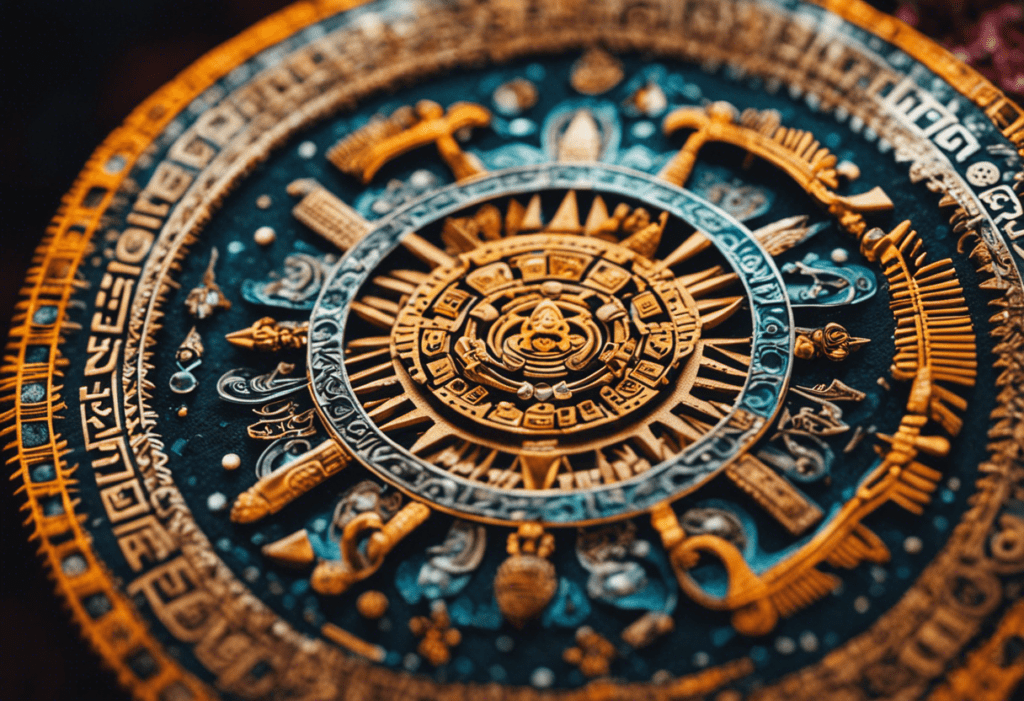Prepare to immerse yourself in the rich and vibrant world of the Aztec Calendar Festivals. This awe-inspiring tapestry of celebrations and rituals offers a profound glimpse into the ancient Aztec civilization.
With festivities dedicated to honoring deities, intricate rituals and ceremonies, and an agricultural cycle steeped in spiritual significance, these festivals are a testament to the deep-rooted customs and traditions of the Aztec people.
Join us as we explore the profound significance and cultural richness of these extraordinary festivities.
Key Takeaways
- Aztec Calendar Festivals played a significant role in religious and cultural practices, reinforcing the belief system and maintaining a connection to the gods.
- These festivals fostered unity and cultural identity among the Aztec people and were also used for social and political control.
- The celebrations involved various offerings, such as human sacrifices, processions, parades, food, flowers, and symbolic objects, as well as vibrant dances, music, and ceremonial games to honor and please the deities.
- The rituals and ceremonies in these festivals included the offering of sacrifices, performance of choreographed dances and music, construction of altars and temples, and seeking blessings from the gods, establishing a connection between the human realm and the divine.
The Significance of Aztec Calendar Festivals
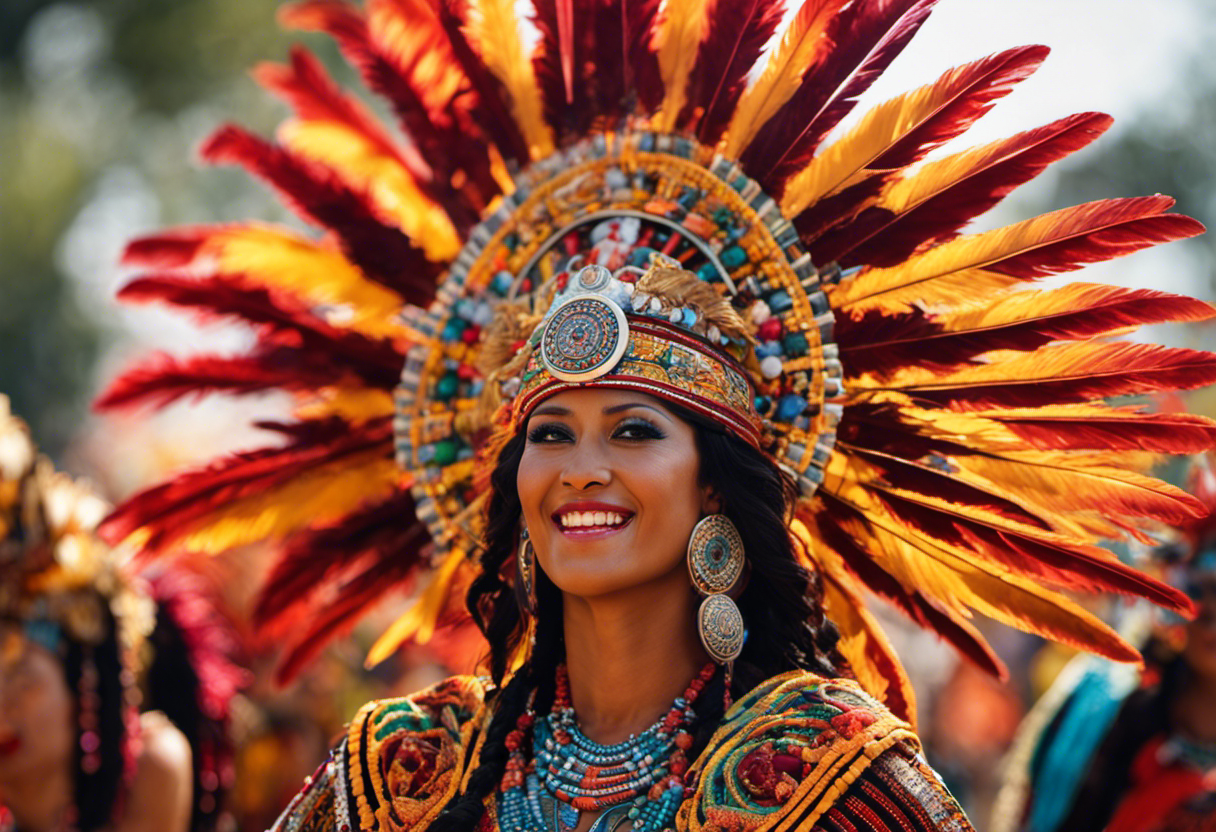

The significance of the Aztec calendar festivals lies in their integral role in the religious and cultural practices of the Aztec civilization. These festivals were not simply occasions for celebration, but rather served as important religious rituals that reinforced the Aztecs’ belief system and connected them to their gods.
The Aztec calendar festivals were deeply rooted in the Aztec’s religious beliefs and were dedicated to various deities. These festivals allowed the Aztecs to honor and appease their gods through offerings, sacrifices, and elaborate rituals. Through these ceremonies, the Aztecs believed they could maintain the balance between the earthly and divine realms, ensuring the well-being of their society.
Furthermore, the Aztec calendar festivals played a crucial role in the Aztec’s cultural identity. These festivals were not only religious events, but also served as opportunities for the Aztecs to come together as a community and celebrate their shared heritage. They provided a sense of unity and belonging among the Aztec people, reinforcing their cultural values and traditions.
In addition, the festivals also served as a means of social and political control. The ruling elite used these events to demonstrate their power and authority, as well as to reinforce the hierarchical structure of Aztec society. By participating in these festivals, individuals were reaffirming their allegiance to the ruling class and the established social order.
Festivities Honoring Deities in Aztec Calendar Celebrations
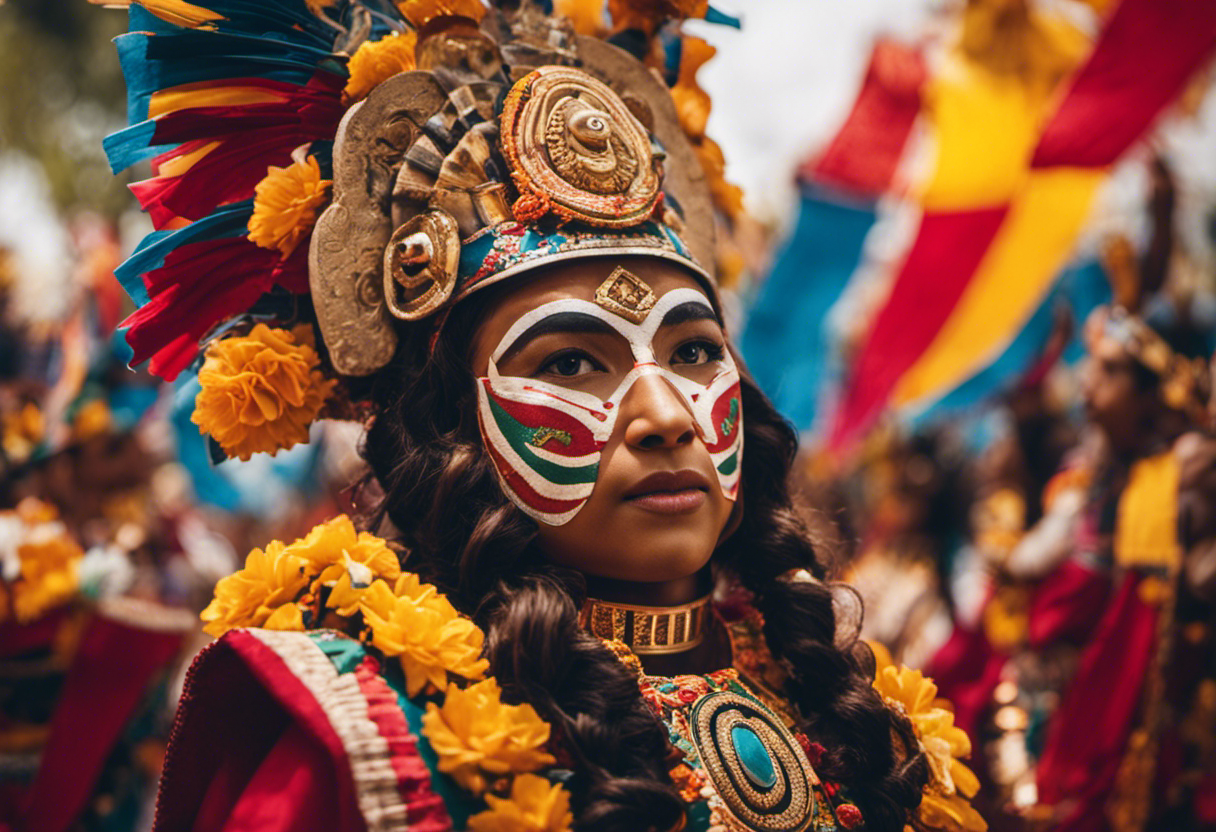

Festivities honoring deities in Aztec calendar celebrations were elaborate and sacred ceremonies that played a central role in the religious practices of the Aztec civilization. These religious ceremonies were deeply rooted in the belief that the gods controlled every aspect of life, and it was essential to appease and honor them through these festivities. The deities in the Aztec calendar were revered and celebrated through various rituals and offerings.
- Human Sacrifice: One of the most significant and controversial aspects of these festivities was human sacrifice. It was believed that sacrificing humans was necessary to ensure the gods’ favor and maintain cosmic balance.
- Processions and Parades: Festivities honoring deities often involved processions and parades, where statues or representations of the gods were carried through the streets. These processions allowed the community to publicly demonstrate their devotion and seek blessings from the deities.
- Offerings and Offerings: Offerings of food, flowers, and other symbolic objects were made to the deities during these celebrations. These offerings were believed to provide sustenance and please the gods, ensuring their continued protection and favor.
- Dancing and Music: Festivities honoring deities were accompanied by vibrant dances and music. These performances were seen as a way to connect with the divine and express gratitude and worship.
- Ceremonial Games: Some celebrations included ceremonial games, such as the infamous Mesoamerican ballgame. These games were not only a form of entertainment but also a way to honor and please the deities, as they were believed to be connected to the cosmic order.
Rituals and Ceremonies in Aztec Calendar Festivals


Rituals and ceremonies played a pivotal role in the Aztec calendar festivals, embodying the spiritual and cultural significance of the ancient civilization. These celebration practices were deeply rooted in the Aztec cultural traditions and were considered essential in maintaining harmony with the gods and the natural world.
One of the most important rituals in Aztec calendar festivals was the offering of sacrifices. The Aztecs believed that sacrifice was necessary to appease the gods and ensure the continuation of life and fertility. This involved the ritual killing of animals, such as jaguars and eagles, as well as human sacrifices, which were considered the most sacred offerings.
Another significant ritual during the festivals was the performance of dances and music. These artistic expressions were believed to connect the human realm with the divine. The dances were highly choreographed and often depicted mythological stories and religious symbols. Music, played on drums, flutes, and other instruments, accompanied the dances, creating a sensory spectacle that engaged both the participants and the spectators.
Furthermore, the Aztec calendar festivals involved the construction of elaborate altars and temples. These structures were adorned with colorful decorations, flowers, and offerings. The priests performed rituals and ceremonies at these sacred sites, invoking the gods and seeking their blessings.
Aztec Agricultural Cycle Celebrations
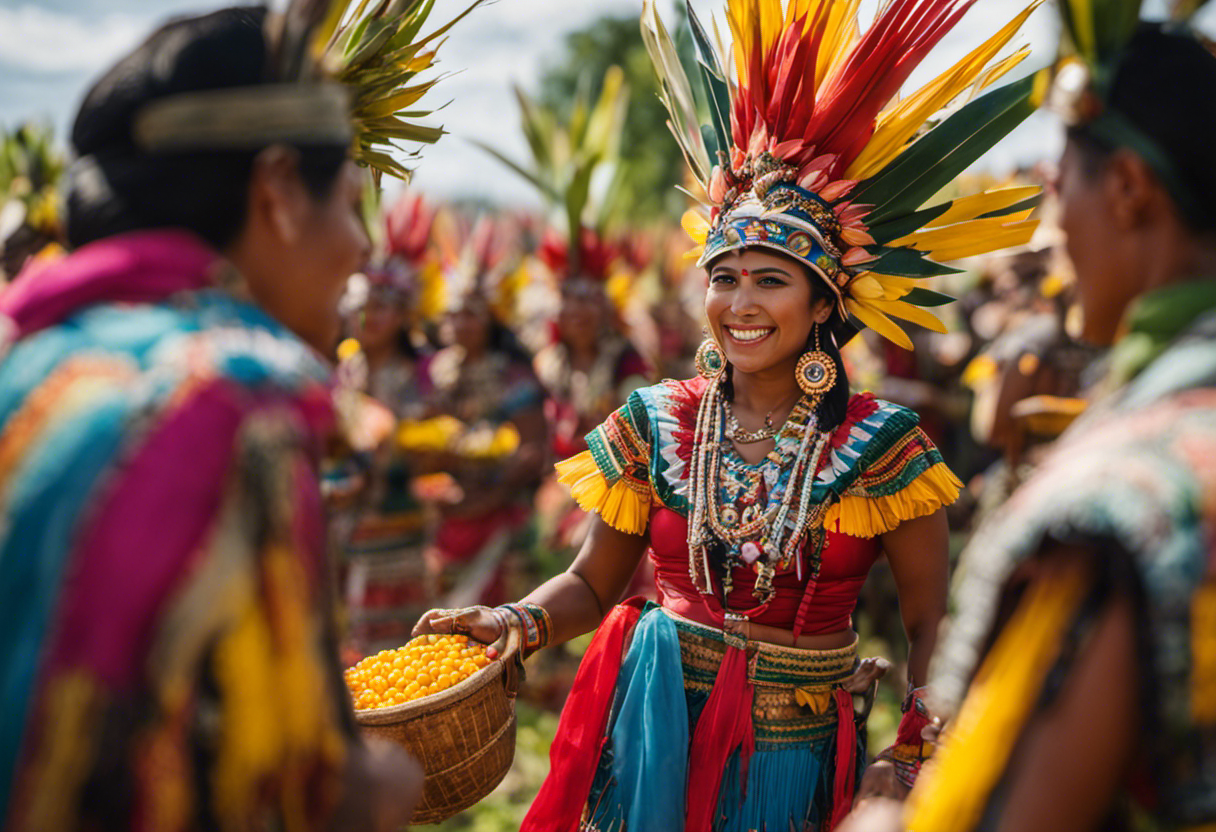

The Aztec civilization placed great importance on their agricultural cycle and celebrated it through various rituals and ceremonies.
These seasonal harvest rituals were an integral part of their calendar festivals, honoring the agricultural deities who were believed to ensure a successful harvest.
Through these celebrations, the Aztecs demonstrated their deep understanding of the connection between agriculture and their survival, as well as their reverence for the gods who controlled the fertility of the land.
Seasonal Harvest Rituals
During the four annual agricultural cycles, the Aztecs celebrated various rituals and ceremonies to honor the bountiful harvest. These harvest traditions and seasonal ceremonies held great significance in Aztec culture, symbolizing the cycle of life and the interconnectedness of humans and nature.
Some key rituals observed during the harvest seasons include:
- Offering of the first fruits: The Aztecs would present the first harvested crops as offerings to the gods, expressing gratitude for the abundance provided by the land.
- Dance and music performances: Festive dances and musical performances were an integral part of the harvest celebrations, with participants wearing colorful costumes and masks.
- Feast and communal meals: The community would come together to share a lavish feast, highlighting the importance of collective effort and cooperation in agricultural activities.
- Blessings and prayers: Priests would lead ceremonies to bless the crops and seek the gods’ favor for a successful harvest in the upcoming seasons.
- Processions and parades: Elaborate processions and parades were organized, showcasing the fruits of the harvest and honoring the gods and deities associated with agricultural abundance.
These seasonal harvest rituals were not only a means of expressing gratitude but also served to strengthen social bonds and reinforce the Aztec belief in the cyclical nature of life and the importance of sustainable agriculture.
Importance of Agricultural Deities
As the Aztecs celebrated the agricultural cycle, they placed great emphasis on the importance of agricultural deities in ensuring a successful harvest. These deities played a crucial role in the Aztec belief system, as they were believed to have control over the forces of nature and fertility. The Aztecs believed that by worshiping these deities and performing agricultural rituals, they could ensure the favor and blessings of these powerful beings.
One such deity was Centeotl, the god of maize and fertility. During the agricultural cycle celebrations, the Aztecs would offer sacrifices and hold elaborate ceremonies to honor Centeotl and seek his guidance and protection. By engaging in deity worship and performing the prescribed rituals, the Aztecs believed they could ensure a bountiful harvest and the continued prosperity of their civilization.
Religious Ceremonies on Important Dates of the Aztec Calendar


Religious observances played a pivotal role in the commemoration of significant dates within the Aztec calendar. These ceremonies were deeply intertwined with the Aztec’s religious beliefs and were seen as essential for maintaining harmony and balance in their world. The Aztecs believed that the gods controlled every aspect of life, from agriculture to warfare, and it was through these religious ceremonies that they sought to appease and honor the deities.
The important dates within the Aztec calendar were marked by various religious ceremonies, each with its own unique rituals and practices. These ceremonies served multiple purposes, including expressing gratitude for past blessings, seeking guidance for the future, and ensuring the well-being of the community.
Some of the religious ceremonies conducted on important dates of the Aztec calendar included:
- Tonalpohualli: A ritualistic ceremony performed every 260 days, which marked the completion of a full cycle of the sacred calendar.
- Huey Tozoztli: A festival dedicated to the god Tezcatlipoca, celebrated in the month of Tozoztli. It involved processions, dances, and sacrifices to ensure the renewal of life and fertility.
- Panquetzaliztli: A festival dedicated to the god Huitzilopochtli, celebrated in the month of Panquetzaliztli. It involved elaborate processions, dances, and offerings to honor the god of war and the sun.
- Ochpaniztli: A festival celebrated in the month of Ochpaniztli to honor the goddess Tlazolteotl. It involved purification rituals and acts of penance to cleanse the community of sin and impurity.
- Xiuhmolpilli: A festival that marked the beginning of a new 52-year calendar cycle. It involved elaborate ceremonies and rituals to ensure the continuity of time and the prosperity of the people.
These religious ceremonies were not only significant for the Aztecs in terms of their spiritual beliefs, but they also served as important social and cultural events that brought the community together. They provided a sense of identity, reinforced social hierarchies, and reinforced the power and authority of the ruling elite. Through these ceremonies, the Aztecs sought to establish a connection with their gods and ensure the continued prosperity and well-being of their civilization.
Traditions and Customs of Aztec Calendar Festivals
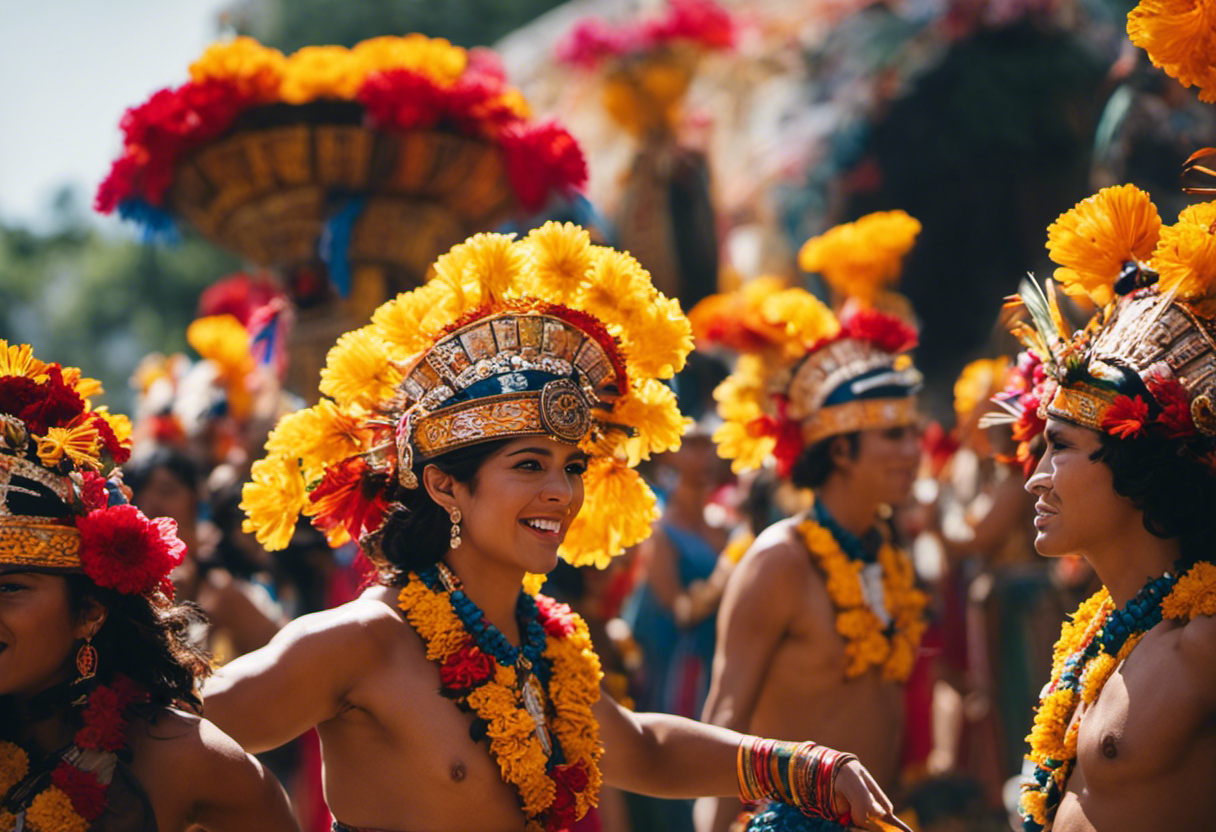

The traditions and customs of Aztec calendar festivals were characterized by meaningful rituals and symbols that held cultural significance and had a lasting impact on the Aztec civilization.
These festivals were not merely celebratory events, but rather deeply rooted in religious beliefs and practices.
Through the observation of specific rituals and the use of symbolic elements, the Aztecs sought to honor their gods, maintain cosmic order, and ensure the prosperity and well-being of their society.
Meaningful Rituals and Symbols
Symbolic representations played a pivotal role in the rich tapestry of customs and traditions observed during Aztec calendar festivals. These symbolic traditions not only added depth and meaning to the celebrations, but also reflected the cultural practices of the Aztec people.
Here are five examples of meaningful rituals and symbols that were commonly seen during these festivals:
- The use of intricate masks and costumes, which represented various deities and supernatural beings, symbolized the connection between the mortal and divine realms.
- The offering of colorful flowers and fruits symbolized the cycle of life and the abundance of nature.
- The use of sacred music and dance was believed to appease the gods and ensure a fruitful harvest.
- The ritualistic bloodletting, through self-inflicted wounds or sacrifices, symbolized the nourishment of the gods and the renewal of life.
- The construction of elaborate altars and temples symbolized the sacred spaces where the gods were honored and worshipped.
These rituals and symbols not only provided a deeper understanding of the Aztec worldview, but also fostered a sense of community and spirituality among the people.
Cultural Significance and Impact
During Aztec calendar festivals, the traditions and customs played a crucial role in preserving the cultural heritage and shaping the collective identity of the Aztec people. These cultural practices had a deep historical significance as they were rooted in the religious beliefs and cosmology of the Aztec civilization.
The festivals were an opportunity for the community to come together and participate in various rituals, dances, and ceremonies that honored their gods and ancestors. Through these events, the Aztecs reinforced their social bonds and transmitted their knowledge and values from one generation to another.
The festivals also served as a means of expressing gratitude for the abundance of nature and seeking divine blessings for the prosperity and well-being of the community. Overall, the traditions and customs of Aztec calendar festivals played a pivotal role in shaping the Aztec culture and maintaining their spiritual connection with the divine.
Conclusion
In conclusion, the Aztec calendar festivals were rich in cultural significance and played a crucial role in honoring deities, conducting rituals, and celebrating the agricultural cycle.
These celebrations were marked by religious ceremonies and followed specific traditions and customs. The Aztec people devoted themselves wholeheartedly to these festivals, which served as a means to connect with their gods and ensure prosperity.
Like a vibrant tapestry woven with threads of devotion and tradition, these festivals painted a vivid picture of Aztec society and its deep-rooted beliefs.

